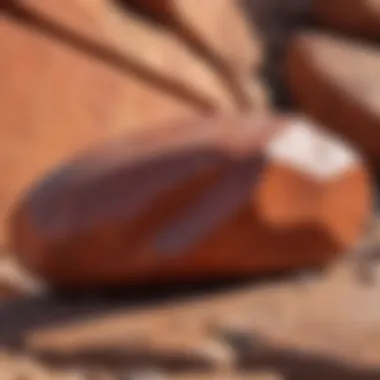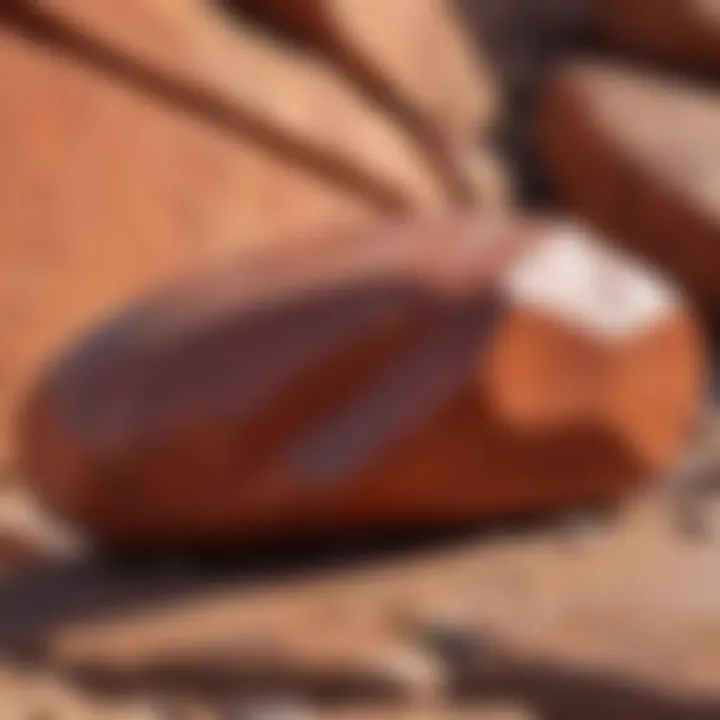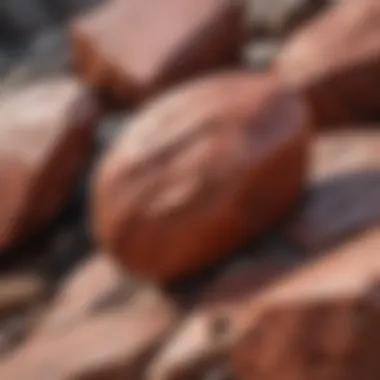Exploring the Intriguing Aspects of Red Granite Rock


Intro
Red granite rock is more than just a breathtaking geological formation; it's a testament to the earth's history and its relentless forces. Formed from molten magma that cools and solidifies beneath the Earth's surface, red granite contains a unique blend of minerals like feldspar, quartz, and mica, giving it its striking hue. This article dives into the captivating aspects of red granite, exploring not only its formation but also its vital roles in art and architecture. By the end, you'll gain a well-rounded understanding of this classic rock, its significance, and why it continues to catch the eye of collectors and enthusiasts alike.
Featured Collectible of the Month
Overview
This month, our spotlight shines on a stunning specimen of red granite, sourced from the renowned mine in Elberton, Georgia. Known for its deep crimson color and impressive durability, this rock has become increasingly sought after among collectors. Not only does it showcase the beauty of natural formations, but it also provides insight into the geological processes that shaped it.
Historical Significance
Red granite has played a crucial role throughout history. One can trace its usage back to ancient civilizations, where it was utilized in monumental architecture and sculptures. The famous Rosetta Stone, for example, is made from red granite. Similarly, many historical structures, like the Egyptian pyramids, have used red granite due to its abundance and resilient nature. Collecting pieces like this isn't just about aesthetics; it connects enthusiasts to a rich narrative that stretches across time.
"Granite, especially red granite, represents the battleground of earth's geological conflicts, witnessing the slow yet might transition of rock into a symbol of resilience and beauty."
Identification Techniques
Visual Characteristics
Identifying red granite is straightforward once you know what to look for. Here are some key visual features:
- Color: A deep hue ranging from rich red to nearly pink, often with speckles or patches of other minerals.
- Texture: Coarse-grained surface that may display a mottled appearance.
- Mineral Composition: Look for the predominant presence of feldspar, which is typically white or pink, along with quartz crystals that may vary in size.
- Luster: The rock has a somewhat shiny surface if polished, often described as glassy.
Resources for Identification
To aid your identification process, consider using the following resources:
- Wikipedia
- Britannica
- Online communities such as Reddit have dedicated threads for rock and mineral identification, where fellow enthusiasts can provide insights and evaluations.
Understanding Red Granite
Exploring the realm of red granite opens a window into not just a mineral, but one of the finest examples of Earth’s majestic creations. Understanding this rock type is crucial for anyone delving into geology, whether you cherish a casual interest or are in pursuit of academic accolades. Red granite, with its striking hue and solid structure, doesn't just catch the eye; it tells a tale of deep-seated geological art that evolved over millions of years. This section will unravel some core aspects of red granite, showcasing its essential traits, uses, and the wonder it inspires.
Defining Granite
Granite is an intrusive igneous rock, primarily composed of quartz, feldspar, and mica. This rock forms from the slow crystallization of magma beneath the Earth's surface, a process that can take many thousands of years. One could say that granite is the result of nature taking its sweet time, allowing minerals to slowly intertwine and solidify into a magnificent mass. Its grainy appearance and color vary based on the mineral content; however, when feldspar predominates, granite may exhibit hues of red, pink, or gray.
So why care about defining granite? Knowledge of what constitutes this rock is vital for rock collectors and enthusiasts alike. Recognizing the characteristics of granite empowers individuals to distinguish it from similar-looking rocks. For instance, being able to differentiate between granite and gneiss could save one from a few awkward conversations at the next geology meet-up. Understanding the basics lays the groundwork for a deeper appreciation of where and how red granite fits in the broader geological tapestry.
What Makes Granite Red?
The vibrant red of granite primarily stems from the presence of potassium feldspar. This particular mineral has a striking red hue caused by its specific chemical composition. Another contributing factor is the micronutrient content, particularly iron. The way this iron reacts during the formation process results in additional variation in shade; it’s fascinating how minute elements can yield such a vivid color palette.
In certain localities, such as the famed Red Rock Canyon in Nevada or the granite quarries of New Hampshire, the reds may appear more vibrant, often due to unique environmental factors surronding their formation.
Understanding what makes granite red enhances the knowledge of rock collectors. If one knows the significance of mineral composition, collectors can identify regions where certain red granites might be found — or be more select about what specimens to add to their collection. This information paints a broader picture of not just what red granite is, but how it connects to the environment, geology, and history, adding a layer of depth that goes beyond mere aesthetics.
"Granite is the most mystical of all rocks, acting as the storehouse of Earth’s secrets, waiting to be uncovered by those keen enough to look deeper."
As we continue exploring the facts, relationships, and uses of red granite, it becomes clear that this rock is not just a geological entity; it is a beacon of natural history and a testament to Earth’s ongoing story.
Geological Formation of Red Granite
Understanding how red granite comes into existence provides valuable insight into its significance. The formation process sheds light on the environmental history of Earth and the geological events that shape our landscape. Red granite is mostly formed through a complex interplay of temperature, pressure, and mineral composition, making it crucial for understanding the larger framework of geology. It’s this formation process that grants granite its unique attributes, playing a pivotal role in its appeal for collectors and builders alike.
Igneous Processes
Red granite is classified as an igneous rock, meaning it originates from the solidification of molten material. When magma from the Earth's mantle rises to the surface, it cools and crystallizes, forming granite. The cooling process can occur either beneath the surface, known as intrusive cooling, or on the surface, which is termed extrusive. In the case of red granite, we often see it formed from slow cooling, allowing big crystals to develop. This slow rate of crystallization is essential; as it creates the coarse texture that is characteristic of this rock.
This slow cooling gives granite its beauty and strength, forming large, visible grains that make it desirable for various applications. The vivid red color typically arises from iron content within the magma, creating a robust visual aesthetic that stands out in both natural and urban settings. The imagination is indeed stirred by the swirling patterns found in its structure, as it tells a story of the Earth’s dynamic interior.
Mineral Composition
Understanding the mineral composition of red granite is vital for appreciating its properties and uses. This rock is primarily composed of quartz, feldspar, and mica, each contributing unique features and benefits to the granite as a whole.
Quartz
Quartz is recognized for its hardiness and resilience, ranking high on the Mohs scale of hardness. This mineral is often responsible for granite’s texture and adds to its overall durability. A key characteristic of quartz is its translucence, which means it can reflect light in fascinating ways. This quality not only enhances the granite's aesthetic appeal but also makes it a popular choice in countertops and flooring.
Moreover, quartz is resistant to weathering and chemical degradation, making it suitable for outdoor landscaping and structures. Its extensive availability in various hues allows collectors to find pieces that resonate with personal preference, from transparent to smoky shades. Overall, quartz enriches red granite, making it an enduring favorite in both natural and designed environments.
Feldspar
Feldspar is another key player in the composition of red granite. Its presence is significant, accounting for nearly 60% of the rock’s volume. Feldspar gives granite its pinkish hue and distinct patterns. The particular forms that feldspar take can vary, with two types generally found in red granite: orthoclase and plagioclase.
What sets feldspar apart is its relationship with light – it can exhibit a shimmering effect known as "adularescence" in some varieties. This unique feature adds a layer of intrigue for collectors and artists alike. Its abundance and versatility make feldspar a practical and economical component in the construction and decorative types of architecture.
Mica
Mica stands out not just for its aesthetic value but also for its unique physical properties. It occurs in thin, flat sheets that can be easily split into thin layers. Mica minerals contribute to granite's internal structure, imparting flexibility and enhancing the rock's ability to withstand environmental stressors.
The glittering fragments of mica within red granite catch the eye, enhancing its overall visual allure. This shimmering aspect can create a captivating effect, reflecting light beautifully, particularly in structures used for art installations or upscale architecture. However, one must consider that while mica offers attractive features, it can also be susceptible to weathering, necessitating proper care in applications where exposure to the elements is prevalent.
Understanding these minerals not only enriches appreciation for red granite but also informs better usage of this magnificent rock in various applications.
Key Characteristics and Properties
Understanding the characteristics and properties of red granite is crucial in appreciating its role in both natural formations and human-made structures. The physical features, durability, and unique color variations serve as vital points of interest for rock enthusiasts and collectors alike. Each property plays a significant role in determining why red granite is favored in a variety of applications ranging from construction to artistic expression.
Physical Properties


Density
Density is a defining characteristic for red granite, measuring the mass of the material per unit volume. This property can indicate the rock's strength and weight, essential factors in its practical applications. Red granite typically exhibits a density ranging from 2.63 to 2.75 grams per cubic centimeter. This substantial density contributes to its reputation as a highly durable material. It's a popular choice for construction projects, especially those requiring robust foundations.
The uniqueness of red granite's density lies in its ability to withstand loads without cracking or breaking under pressure. This makes it particularly beneficial for structures like bridges and monuments. However, one downside is that the heavy weight of red granite can complicate transportation and handling during construction.
Hardness
Hardness reflects the resistance of red granite to scratching and abrasion. The Mohs scale, which ranges from 1 (talc) to 10 (diamond), places red granite around a 6 to 7, depending on its mineral composition. This hardness makes the rock a resilient choice for countertops, flooring, and even decorative elements, where durability is a top priority.
The strength provided by the hardness of red granite is key to its longevity in both indoor and outdoor settings. It is an excellent choice for high-traffic areas, as scratches and other forms of damage are less likely to occur over time. However, it's worth noting that while its hardness provides great durability, it can also be challenging to carve or shape, which may deter some artists from using it in detailed sculptures.
Color Variations
Color variations in red granite result from the minerals present during its formation, specifically feldspar, quartz, and biotite, which can introduce shades ranging from bright crimson to muted terracotta. This aspect is not only visually appealing but also plays into the aesthetic decisions of architects and artists.
A distinctive feature of red granite's color is its ability to shine in the sunlight, imparting a rich, vibrant hue that enhances its desirability for landscaping and architectural elements. Collectors often seek out specific color tones that resonate with their preferences, making variation a beneficial aspect in the marketplace. On the flip side, the perception of color can vary based on lighting conditions and environmental factors, which may sometimes lead to mismatches in expectations.
Durability and Weathering
The durability of red granite is perhaps its most celebrated characteristic. This rock type exhibits outstanding resistance to weathering, erosion, and the general ravages of time. It can withstand intense weather conditions without losing its integrity, making it ideal for outdoor constructions like monuments, bridges, and pavements.
Granite’s slow rate of weathering also means that pieces can last for centuries, a factor leading to its historical significance in architectural works. However, while it is resilient, red granite can still be affected by certain environmental factors, such as acid rain, which can alter its surface over extended periods.
Red granite serves not only as a robust building material but also as a testament to the beauty and durability inherent in natural rock formations. Its physical and aesthetic properties make it a favorite among rock enthusiasts, construction professionals, and artists alike.
"The properties of red granite don’t just define its physical form; they also underscore its significance as a material that transcends time and culture."
By uncovering the intricate characteristics of red granite, enthusiasts can develop a deeper appreciation for its application in their collections or in the myriad buildings and sculptures that grace the world.
Historical Significance of Red Granite
The role of red granite in history cannot be understated. This striking stone has served many purposes across cultures and time periods, serving as not just a material but a symbol of strength, endurance, and artistic expression. From ancient civilizations to modern interpretations, its enduring presence speaks volumes about human ingenuity and artistry.
Ancient Civilizations
Egyptian Monuments
In ancient Egypt, red granite was a prized material, commonly used in the construction of monumental structures. Temples and tombs, like the ones found in Giza, boast impressive red granite blocks, which were not only durable but also imbued with spiritual significance. The choice of this rock was often linked to the gods and the afterlife, as Egyptians regarded it as a stone that represented immortality.
One notable structure is the Red Pyramid at Dahshur, which showcases the early use of this rock. Its pinkish hue, visible even from a distance, conveys a sense of majesty and permanence. This unique characteristic made it a highly sought-after choice for lasting monuments. Additionally, its durability offers insights into ancient Egyptian engineering, proving how advanced these civilizations were in their techniques.
The weight of red granite also presents challenges. Transporting such massive blocks from quarries to construction sites required not just manpower but clever innovations. This resulted in a myriad of ancient tools and methods that showcase the resourcefulness of early builders.
Mesoamerican Structures
Similarly, Mesoamerican cultures, like the Maya and Aztecs, recognized the importance of red granite. Notably, the large ball courts and temples constructed in this material conveyed both practical and ceremonial purposes. Temples adorned with red granite had a sacred connection, often linked to the sun, which many cultures revered. For instance, the El Castillo at Chichen Itza features red granite in its facade, highlighting its importance.
The key characteristic of Mesoamerican structures built with red granite lies in their intricate designs and elaborate ornamentation. The stone’s ability to hold fine detail enabled artisans to create stunning reliefs and sculptures that tell stories and embody rich cultural narratives. However, working with granite posed challenges; the hardness of the stone made it labor-intensive to carve.
Modern Interpretation
In modern times, the legacy of red granite continues to influence architecture and landscaping. Its prestigious aura makes it a favorite in the construction of public monuments and high-end buildings. The natural beauty, coupled with exceptional durability, has led to its use in everything from memorials to corporate logos. As society grows increasingly concerned about sustainability, some modern architects emphasize sourcing granite from local quarries, which also honors traditional practices.
"The allure of red granite remains profound, connecting our history with contemporary designs, crafting a tapestry that reflects both durability and beauty."
Understanding its historical significance offers insight into human culture, evolution, and craftsmanship, making red granite more than just a rock but a narrative woven through time.
Cultural Impact
The significance of red granite rock extends well beyond its geological properties and applications in construction; it also plays a pivotal role in culture and art. This section delves into how red granite has influenced various aspects of human expression and architectural design.
Art and Sculpture
Red granite has been a favored medium among sculptors for centuries, prized for its durability and striking appearance. Artists often choose this stone because of its ability to withstand the tests of time while offering a visually appealing finish. Statues made from red granite stand firm against the elements, making them ideal for outdoors, where they can be admired for generations. The strong hues of red in the granite can evoke emotions or tell stories, making this stone a canvas for both modern and ancient artistry.
Many notable sculptures around the world exemplify the artistic capability of red granite. For example, the famous Moses statue by Michelangelo is a prime illustration of how granite can be transformed into detailed figures, capturing the viewer's attention. The texture and variations in color can add depth to the piece, showcasing the artist's skill while celebrating the natural beauty of the stone.
Architecture
Use in Monuments
Red granite is a salient choice for constructing monuments, primarily due to its timelessness and strength. Many significant landmarks are carved from this stone, which are not merely functional but also symbolize societal values and historical narratives. The reddish hue often signifies power and permanence, which is why it's commonly seen in memorials, gravestones, and other historic structures.
The most remarkable characteristic of these monuments is their ability to endure. They withstand harsh weather and human intervention, serving as a testament to the cultures that built them. Within many communities, red granite monuments become focal points, bringing people together to remember their past and celebrate their heritage. One might even find that the tactile warmth of granite evokes a sense of connection to the earth, making it a honoring material for commemorating significant events or individuals.
Contemporary Buildings
In the realm of contemporary architecture, red granite continues to gain prominence, particularly for facades and flooring in commercial buildings. The aesthetic versatility of this rock makes it suitable for a multitude of modern designs. Architects appreciate how red granite can be integrated into various styles, from sleek and minimalistic to more ornate and classical designs.
A unique feature of using red granite is its maintenance of visual appeal alongside practical benefits. This rock is not only strong but also remains relatively easy to clean, sustaining its vibrant appearance over time. However, one must note that it may not be the most eco-friendly option when considering the extraction processes. Still, it stands as a testament to engineering ingenuity, showcasing how natural resources can be employed creatively in modern construction.
"The use of red granite in buildings is a reminder that while technology advances, the connection to our natural world remains integral."
In summary, red granite's cultural impact spans both the realms of individual artistry and architectural significance, making it a vital component in expressing human experience through time.
Extraction and Processing
When discussing red granite, one cannot overlook the significance of extraction and processing. This stage is not just about digging stones out of the ground; it involves a deep understanding of geology, engineering, and craftsmanship. Proper techniques during this phase ensure high-quality materials for construction, art, and architectural projects while minimizing environmental impact. As red granite continues to be a favored choice for many applications, knowing how it is extracted and processed becomes essential for enthusiasts and professionals alike.
Quarrying Techniques


Quarrying techniques vary, but the essentials often focus on maximizing efficiency while preserving the integrity of the rock. Open-pit mining is one common method used for red granite extraction. In this approach, a large section of land is cleared, and workers use heavy machinery to break the granite into manageable blocks. This method enables access to vast granite deposits but can create significant landscape alterations.
Another technique is wire saw cutting, which utilizes diamond-embedded wire to slice through the granite with precision. This method minimizes the risk of cracking, allowing for larger, intact pieces to be harvested. The cuts are clean, leading to less waste and ensuring that the quality remains intact. A study published on britannica.com suggests that advancements in quarrying technology, such as wire saws, have made it easier to obtain large and high-quality granite slabs.
- Benefits of Modern Techniques:
- Reduced wastage of material
- Greater accuracy in cuts
- Less environmental disruption
However, quarrying is not without its challenges. It must be performed with a keen eye on environmental considerations. Protecting surrounding ecosystems and minimizing the footprint of operations are now more critical than ever. Quarry operators tend to follow sustainable practices to minimize adverse effects on the environment. Regulations are in place, ensuring that the landscape is rehabilitated post-extraction.
Finishing Methods
Once the granite is extracted, the next step is the finishing process. This stage refines the raw blocks into the gorgeous slabs and tiles used in modern architecture and art. Various finishing methods are employed, each imparting distinct characteristics to the granite.
- Polishing is a popular technique that creates a glossy surface, accentuating the deep reds and unique textures of the stone. Using diamond abrasives, the surface is ground and polished until it achieves that reflective shine, turning heads in any installation.
- Flaming involves exposing the granite to extreme heat, creating a textured surface. This method is particularly useful for outdoor applications, as it provides better grip and is resistant to slipping. It also enhances the stone's natural color variation, making the red hues pop even more.
- Honing results in a matte finish, offering a softer appearance. This method is particularly favorable indoors, giving spaces a more understated elegance without the glare of a polished surface.
The choice of finishing method heavily depends on the intended use of the granite. For instance, a polished surface might be ideal for kitchen countertops where aesthetics reign supreme, while a flamed finish may work better on outdoor pathways due to its practicality.
"The finishing methods applied to red granite not only enhance its beauty but also emphasize its durability and suitability for various applications."
With the right combination of quarrying techniques and finishing methods, red granite can go from a raw geological marvel to a stunning centerpiece in your home, office, or historical landmarks. It is a testament to how human ingenuity and nature's gifts can unite seamlessly.
Environmental Considerations
The topic of environmental considerations is paramount in the discussion of red granite rock, shedding light on both the ecological impacts of its extraction and the sustainable practices that can counterbalance those effects. Understanding these factors is essential for anyone involved in the rock and fossil collecting community, particularly as it relates to responsible sourcing and conservation efforts.
Impact of Quarrying
The quarrying of red granite presents a double-edged sword. On one side, it provides valuable material for construction, landscaping, and artistic endeavors. On the other hand, the extraction process can lead to significant environmental degradation. This includes the destruction of habitats, disruption of local ecosystems, and alteration of the landscape itself.
One notable impact is the alteration of water drainage patterns. When quarries decimate the land, they can lead to soil erosion and increased runoff, which can pollute nearby water bodies. The habitat destruction can also displace wildlife, pushing them further away from their natural environments. Furthermore, the heavy machinery used in quarrying contributes to noise pollution and emits greenhouse gases, adding to the broader issue of climate change.
In essence, the demand for red granite needs to be balanced with a conscientious approach to extracting it.
Sustainability Practices
Considering the impacts of quarrying, certain sustainable practices have gained traction that can help mitigate environmental concerns associated with red granite extraction. These practices promote eco-friendly approaches that aim to balance industrial needs with environmental stewardship.
- Responsible Sourcing: Companies are increasingly adopting policies that ensure granite is sourced from quarries that follow environmental regulations. This includes knowing the source’s operational methods and adherence to ecological standards.
- Recycling and Reusing Leftovers: Instead of discarding the waste generated during granite extraction, companies can repurpose it for smaller projects, such as decorative stones or sidewalk paving. This reduces waste and utilizes the material more efficiently.
- Reforesting: After a quarry is depleted, responsibly replanting trees and restoring the natural flora can help heal the landscape. This not only restores habitats but can also improve air quality and enhance biodiversity.
- Water Management: Implementing better water management strategies helps to minimize the impacts on local waterways. Treating water before it is discharged back into the environment reduces harmful pollutants that may have been collected during the extraction process.
Adopting these sustainable practices is vital, ensuring that the beauty and utility of red granite rock can be enjoyed without compromising the environment for future generations. By focusing on these considerations, the rock and fossil collecting community can advocate for responsible practices in both quarrying and usage, helping to pave the way for a more sustainable future.
Applications of Red Granite
Red granite, celebrated for its robustness and striking aesthetic appeal, finds a significant place in numerous industries and consumer applications. From large-scale construction projects to intricate decorative pieces, the versatility of red granite cannot be overlooked. This section explores the various applications of red granite, outlining its importance and the benefits it brings to different domains.
In Construction
When it comes to construction, red granite is a heavyweight champion. Often used in foundational work and structural components, this rock's strength and durability are unmatched. Granites are metamorphosed igneous rocks, which means they stand the test of time, offering resilience against the harshest weather conditions and structural stresses.
Architects and builders frequently opt for red granite for:
- Exterior Facades: Its distinct color and texture can add depth and character to buildings. Many urban structures now feature red granite as a central design element, enhancing curb appeal.
- Paving and Walkways: The high wear resistance makes red granite ideal for pavements and walkways. It can withstand heavy foot traffic while retaining its aesthetic charm over time.
- Staircases and Monumental Steps: The stone is also popular for stairs, both indoors and outside. The weight of red granite provides stability, while its grain adds elegance.
Ultimately, the advantages of using red granite in construction boil down to not just beauty but also the assurance of longevity and minimal maintenance. This makes it a favored choice among builders eager to deliver reliable, lasting structures.
In Landscaping
Landscaping is another area where red granite shines like a diamond in the rough. The vivid hue and patterned surface can transform dull outdoor spaces into vibrant landscapes. Red granite offers a natural appeal that complements various garden designs.
Here are a few popular uses of red granite in landscaping:
- Retaining Walls: Its ability to bear weight under pressure makes it an excellent choice for retaining walls in gardens, terraces, and other landscaped areas.
- Decorative Stones: Landscapers often use red granite as decorative gravel in flower beds or rock gardens. It adds visually appealing colors and textures, giving gardens a polished look.
- Water Features: Many ponds or fountains incorporate red granite boulders, which not only serve practical purposes but also beautify the surrounding spaces.
Incorporating red granite into landscaping can create unique, visually striking designs that appeal to the eye while also providing practical functionality. Thus, both aesthetic and utility factors contribute to its popularity in landscaping projects.
In Home écor
The charm of red granite extends indoors as well, making it a favored choice in home décor. Its luxurious, polished finish and rich coloring can elevate the look of residential spaces. Homeowners and designers rely on red granite for its elegance and versatility in various decorative applications.
Consider these avenues of using red granite:
- Countertops: Red granite countertops are a popular choice in kitchens and bathrooms, offering not only beauty but also heat and stain resistance.
- Fireplaces: Utilizing red granite in fireplace surrounds brings warmth and a sense of sophistication to living spaces.
- Sculptures and Artifacts: Home décor isn't limited to construction. Red granite sculptures or art pieces can serve as stunning conversation starters, showcasing both artistry and nature.
From functional pieces to striking artistry, red granite provides a rich and varied palette for home design, allowing for creative interpretations of style and comfort.
In summary, the applications of red granite are vast and varied, transcending mere utility to encompass beauty and durability. Its role in construction, landscaping, and home décor highlights its versatility and enduring appeal.
Collecting Red Granite Samples
Collecting red granite samples can be a thrilling endeavor for both seasoned rockhounds and newcomers alike. The vibrant hue of red granite not only serves as an aesthetic marvel but also tells a detailed geological story. These specimens carry the weight of natural history, encapsulating the processes that formed them over millions of years. For enthusiasts, collecting red granite is more than a hobby; it’s a pursuit steeped in passion and knowledge.
Gathering samples encourages a deeper appreciation for geology, leading to a broader understanding of the intricate dynamics of Earth’s crust. Furthermore, these samples can serve educational purposes, showcasing the mineral composition and formation stories behind them.
Identifying Authentic Samples
One of the essential skills for any collector is being able to distinguish genuine red granite from imitations or lower-quality stones. Authentic red granite typically showcases a few key features that serve as identifiers:
- Color Consistency: Genuine red granite exhibits a rich and uniform color, often with slight variations due to mineral inclusions. If your sample looks too uniform or artificial, it's worth investigating further.
- Grain Structure: Examine the texture. Real granite has a grainy appearance, with visible crystals of quartz and feldspar. If the surface feels too smooth or waxy, it could be a sign of a synthetic product.
- Weight: While not definitive in isolation, the heft of authentic granite often stands out. It tends to be noticeably denser than common stones.
- Sound Test: A simple tap test can reveal a lot. Genuine granite resonates with a clearer tone compared to less dense rocks or artificial materials.
Another common pitfall is confusing red granite with red quartzite. The former has a more crystalline texture, whilst quartzite, although beautiful, lacks the same igneous origin.


Caring for Your Collection
Once you’ve begun your collection, the next step is maintaining the integrity of your specimens. Proper care not only preserves the visual appeal of red granite samples but also safeguards their geological value.
- Clean with Care: For routine cleaning, a damp soft cloth will usually suffice. If your samples are particularly dirty, a mild soap solution can be employed. Steer clear of harsh chemicals, as they can cause pitting or dull the surface finishes.
- Avoid Direct Sunlight: Like any natural material, prolonged exposure to sunlight can fade colors and alter the appearance of your specimens. Store them in a cool, shaded area.
- Display Wisely: Use sturdy display methods that will hold your samples securely. Consider using padded display cases or shadow boxes to minimize movement and prevent chipping.
- Routine Checks: Regularly inspect your collection for signs of wear or damage. Early detection can prevent further deterioration and maintain the quality of your rocks.
Collecting and caring for red granite can be deeply rewarding, blending the wisdom of geology with the creativity of display.
Following these tips can turn a simple interest in red granite into a lifelong passion, enriching your understanding of this remarkable rock while preserving its natural beauty for years to come.
Scientific Research and Red Granite
Scientific research concerning red granite is vital, not only for deepening our understanding of geological processes but also for uncovering its multifaceted significance in various domains. Red granite stands out as a subject of study due to its unique mineralogical composition and its role in the Earth's narrative. Understanding this type of rock helps in comprehending larger geological and environmental contexts. The insights gathered from scientific research can inform sustainable mining practices, preservation, and even offer clues about past climatic conditions.
Geological Studies
Geological studies focusing on red granite encompass a range of topics, including its formation, distribution, and the processes of weathering and erosion it undergoes over time. Researchers meticulously analyze rock formations to understand how large-scale tectonic movements have influenced the current landscape. These studies often involve collecting rock core samples from diverse locations, which showcase the variations in red granite across regions.
For instance, granite from the Sierra Nevada in California can differ significantly in mineral content and appearance from granite found in the Scottish Highlands. Such diversity stems from different geological histories, underlying magma cooling processes, and the specific minerals present.
Key benefits of these geological analyses include:
- Mapping and locating viable quarry sites.
- Understanding past environmental conditions, which can help in predicting future changes.
- Informing conservation efforts by identifying vulnerable geological sites.
Mineralogical Research
Mineralogical research is another essential aspect of studying red granite, as it delves into the rock's crystal structure, composition, and the properties of its constituent minerals. The primary minerals found in red granite include quartz, feldspar, and biotite. Each of these minerals carries its own story, reflecting the conditions under which the granite formed.
- Quartz gives red granite its durability and resistance to weathering. Its abundant presence ensures that this rock can withstand environmental stresses for extended periods.
- Feldspar, commonly the reddish variety, contributes to the rock's color. The variations in feldspar can help geologists trace the granite’s origin and the specific conditions of its formation.
- Biotite, a mica mineral, not only adds to the texture but also influences how the granite interacts with elements in its environment.
Through spectroscopic analyses and microscopic examination, researchers uncover the finer details of mineral interactions within red granite. This knowledge is crucial for various applications, from construction materials to understanding geological hazards.
"The interplay of minerals in red granite is fascinating, revealing past conditions and hinting at future geological developments."
Thus, both geological and mineralogical research create integrated insights about red granite, emphasizing its ecological and historical context. This two-pronged approach underscores the importance of red granite not just as a physical entity but also as a narrative leading back through time.
Symbolism and Myths
The topic of symbolism and myths surrounding red granite rock holds a notable place in the broader narrative of mineralogy and cultural studies. It showcases how geological formations, particularly red granite, are more than just raw materials; they are deeply embedded in the cultural consciousness of societies throughout history. This section delves into various concepts, tapping into cultural symbolism and the mythical tales that give granite a revered status across different civilizations.
Cultural Symbolism
Red granite isn't just a stone; it embodies strength, resilience, and permanence. Many cultures see this vibrant rock as a symbol of longevity due to its enduring nature. Its ability to withstand the test of time resonates deeply with the human experience. For instance, in Egyptian culture, the red granite used in monumental architectures like the temples and pyramids symbolizes the connection with the divine and the eternal. The redness in granite often signals power and importance, making it an ideal choice for structures meant to inspire awe and reverence.
Often, red granite appears in sculptures and art pieces, indicating its association with passion and vitality. Artists use this stone not just for its aesthetic appeal but also for the messages they wish to convey. In places like India, where rituals and spirituality are intertwined, red granite has been used for centuries to create sacred spaces, enhancing the significance ascribed to the area it adorns. The connection between red granite and emotional depth creates layers of meaning that enrich our understanding of culture and identity.
- Strength: Seen as unyielding and solid, representing durability.
- Passion: The color red often evokes strong emotional responses.
- Spirituality: Utilized in sacred architecture and art, enhancing cultural reverence.
Myths Surrounding Granite
Throughout history, intriguing myths have sprouted around granite, particularly the red varieties. Ancient civilizations often attributed mystical properties to natural elements, and granite was no exception. There are tales that speak of giants who shaped the land using massive boulders of granite, suggesting that these stones are remnants of their deeds.
In North America, certain Native American tribes regarded certain types of red granite as sacred, believing it was formed from the blood of ancestors who fought valiantly in battles, hence tying the stone to themes of sacrifice and valor. These narratives enrich the cultural landscape, demonstrating how something as passive as rock can carry profound meanings and stories.
"In every great story, there lies a humble granite rock—silent witness to the passage of time and human emotion."
Moreover, some might argue that granite is viewed as a talisman of protection. It was said that carrying a small piece of red granite could guard against misfortune, stemming from the belief in the stone's unwavering strength. Over time, these myths evolve but remain tethered to a sense of identity, illustrating humanity's desire to find meaning in the physical elements of nature.
The interplay between the cultural symbolism and myths not only deepens our appreciation for red granite but also highlights the narrative power it holds, connecting generations through shared stories and collective experiences.
Future of Red Granite
As we turn our gaze toward the future of red granite, it's important to note that this timeless rock is not just a relic of the past; it's very much part of our evolving landscape. The future of red granite can be shaped significantly by innovations in extraction techniques and sustainable practices that address the environmental impact of quarrying. With the increased demand for granite in both construction and decorative applications, the need for responsible mining and processing methods has never been greater.
Technological Advances in Extraction
The advancement in extraction technology has the potential to reshape how we interact with red granite. Traditional methods often involve significant waste and negative environmental impacts, yet modern techniques are increasingly turning the tide. Here are some notable developments:
- Diamond Wire Saws: These tools allow for precision cutting with minimal waste. Unlike saws with blades that can lose significant material during cutting, diamond wire saws use a thin wire embedded with diamonds. This results not only in cleaner cuts but also in preserving more of the granite block.
- Robotics: Automation in quarrying could also be a game changer. By using robotic equipment to handle the heavy lifting, workers can operate from safe distances, reducing the likelihood of accidents and allowing for more precise operations.
- Water Jet Cutting: This method employs high-pressure water jets to slice through rock without generating heat, which can cause fractures in the granite. It is less environmentally taxing and can maintain the coolness of the material.
Technological innovations like these not only enhance efficiency but also lead to safer working conditions and reduced ecological footprints. With the increasing public and governmental scrutiny on how natural resources are mined, such advancements will become crucial in meeting both market demand and sustainability goals.
The Role of Red Granite in Sustainable a Future
The relevance of red granite extends into the realm of sustainability and environmental stewardship. As we face climate change and resource depletion, red granite can play a pivotal role:
- Recyclable Material: Unlike many construction materials that end up as waste, granite can be reused and recycled. Fragments of granite from slabs and leftover cuttings can be repurposed for aggregates or decorative features, cutting down on the need for new extraction.
- Durability and Longevity: Red granite's innate strength makes it a desirable choice for structures that must last centuries. By choosing to build with durable materials like red granite, we invest in sustainable living spaces that require less maintenance and fewer replacements over time.
- Natural Aesthetic: In landscaping and architecture, the warm hues of red granite can enhance the appeal of a design while blending seamlessly with nature. Using locally sourced granite reduces transportation emissions, supporting local economies and decreasing the carbon footprint of building projects.
"By integrating red granite into sustainable building and design practices, we not only preserve our environmental resources but also honor the earth's natural beauty."
Closure
In wrapping up our exploration, it’s crucial to emphasize the multifaceted significance of red granite rock, both in geological and cultural contexts. This article has taken a deep dive into how red granite is more than just a visually striking material—it serves as a testament to the natural processes that have unfolded over millennia. From its formation beneath the Earth’s surface to its applications in art and architecture, red granite captures the imagination and intellect of enthusiasts.
Recapitulating Key Insights
A couple of key insights emerge from our discussion:
- Red granite originates from the slow cooling of magma, allowing large crystals, mainly quartz and feldspar, to develop. This unique formation process gives it durability and a distinct aesthetic.
- Throughout history, red granite has not just been a resource; it embodies cultural heritage, seen in the great monuments of ancient civilizations. For example, the Egyptian pyramids and various Mesoamerican structures utilized this rock effectively, associating it with longevity and power.
- In contemporary times, red granite continues to find use in modern architecture, offering a blend of beauty and resilience crucial for enduring designs.
The Enduring Appeal of Red Granite
The lasting appeal of red granite can be attributed to a combination of its physical properties and cultural resonance. Collectors and enthusiasts are drawn to its vibrant hues and the depth of character that every piece holds. Each sample tells a story—its age, origin, and the environmental forces that shaped it over millennia. Such qualities make it not just a rock, but a unique artifact that connects us to the Earth’s history.
Moreover, as sustainability becomes a central focus in modern practices, the role of red granite in eco-friendly construction is increasingly valued. This geological wonder not only satisfies artistic and architectural aspirations but also aligns with the growing demand for responsible sourcing and environmental stewardship.
To sum it up, the appeal of red granite lies in both its tangible attributes and its intangible connections to human history and progress. As we step into a future increasingly focused on sustainable practices, red granite will undeniably carve out its niche in both the geological and cultural landscapes, making it ever more relevant to collectors and scholars alike.



